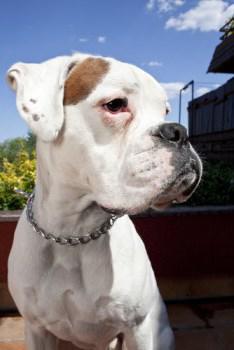White Boxer Dogs
Overview
Regrettably, some people still believe that white Boxer dogs or puppies are the least favorable of the breed. Some will argue that those dogs born white are more prone to illness or more aggressive than the other more traditionally colored dogs of the breed. Some think that they have a different set of personality traits and will show different behavior than more traditionally colored dogs.
For those of us who are lucky enough to love a white Boxer puppy...This simply could not be further from the truth.
There is a lot of false information that can easily be found...So, let's clear this up by looking at the facts.
While each dog is an individual and has his or her own personalty quirks, in general, white Boxer dogs will behave exactly like most other more traditionally colored pups and dogs. There is no set change in disposition, aggressiveness or any other trait. Most, if not all Boxers are comical, fun loving and expressive animals with a strong craving to please their owners. They are excellent companions, family pets and enjoy the company of their humans.
A white Boxer dog is not automatically ill or blind or has eye issues...and this color is actually not that rare. In fact, 25% of all Boxers born are white. And the majority of them (70 - 75%) are born perfectly healthy.
What Causes This Coat Color
White Boxers are not the result of genetic birth defects. Just as human hair is the product of the combined genetics of the human parents, the color of a Boxer puppy’s coat is determined by the genetics of both the father (sire) and mother (dam)…
Also color can skip a generation and a Boxer may have the color of his or her grandmother or grandfather. In some cases, color can go back as far as 5 generations.
Both of the parents must carry the genetic code white. In every way the puppy is the same as all of its siblings…with all the liveliness, traits, and spirit that make them Boxers.
A white Boxer is not an albino. Albinos entirely lack pigment. Any dog breed will infrequently have an albino…although it is very rare. When a dog is an albino there is no colored pigmentation anywhere on the dog…They have pink eyes, and a complete lack of color anywhere on the body.
Most white Boxer dogs have some spots on their skin (which can be seen due to their short coats) and have some markings around their nose and mouth. Some have colored markings in their coat (such as brown spots around an eye or on the back, etc). They will have pigment in their eyes, this alone rules out albinism as the cause of their whiteness.
They are especially beautiful and expressive looking, as their eyes stand out very much and they often have the “puppy dog look” that makes us melt.
Approximately one in four puppies are white (either all white or majorly white). Therefore, this is not a rare color.
Even so, the AKC Boxer breed standard requires that 2/3's of the body be either fawn or brindle in color. Because of this limitation, white Boxer dogs do not meet the breed standard for show conformation. Many breeders and handlers hope that this changes. White Boxers, as beautiful as they are, may someday be accepted for conformation in AKC show events.
There are breeders (and people in the general public) who feel that white Boxer dogs are inferior to fawn or brindled colored Boxers and have more health problems..
Fortunately, the American Boxer Club allows for white Boxers to be registered with the AKC on limited privilege.
Recently, there has been more studies to either substantiate or dissuade the claims that white Boxers are more prone to problems than standard colors. The only claims that seem to have merit are:
- They are more likely to sunburn
- And the white Boxer (like many other breeds with similar loss of pigment) are more prone to deafness in one or both ears.

"A Girl and Her Boxer"
Bullet & best friend Claire
Photo courtesy of owner: Lily
10 Quick FACTS
1. They are not rare -Approximately 25 percent of all boxers born are white.
2. They are not albinos – They have colored eyes, colored touch, inside of the ears, belly and bottom of the paws.
3. They can sunburn easy – an owner should use human sunscreen on their dog if they are to be outside for more than 30 minutes – And remember that the UV sun rays CAN penetrate through clouds, so it is better to be safe than sorry.
4. They can be deaf and this is one of the biggest reasons why most breeders do not purposefully breed for the white color. Approximately 25 to 30% will be deaf either in one ear or both.
5. Blindness is a bit more common with the white Boxer.
6. Some people believe that white Boxers develop cancer more easily than the more standard colored dogs; however this is still up for debate and has not been proven.
7. They can be registered BUT they currently do not meet the American Boxer Club's standard.
The member’s code of ethics states that it is an infraction to register with the American Kennel Club a Boxer of any color not allowed by the set standards. The AKC will deny registration for any puppies born to a registered white Boxer.
8. Due to the fact that deafness IS more common with this colored dog, it is highly recommended to spay/neuter your white Boxer unless you are planning on keeping all of the potential puppies…since public opinion may make it difficult to place them in loving homes.
9.
They have the same temperament and personality as other Boxers..They are happy, loyal, social, friendly dogs when raised in a loving, appropriate home.
10.
When one has spots of fawn or brindle on them, almost to the point of 50/50, the dog is called a “Check”.
Note:
Opposite to this, you may be interested in reading: Boxer Dogs Without White Markings
The Difference Between White Boxers and Check Boxers
The terms whites and checks are often used interchangeably but this is not correct…Because they are very different. The white Boxer may have pigmented patches around the eyes and ears and other limited points on the body, but the Check has much more pigment and could be called piebald (50:50).
The white carries two doses of the extreme white spotting gene, s-w (s-w/s-w) and is produced 2 “Flashy Boxers”. A flashy Boxer is one who carries one dose of the gene.
The Difference Between White Boxers and Albino Boxers
Albinism is a complete lack of color pigmentation. and this can happen with canines but is very rare. An albino Boxer dog would have no color on the skin as well; the eye rims, nose, bottom of the paw pads, and lips would be pink. In addition, most albino dogs have very light eyes.
White Boxers, on the other hand, will have some
skin pigmentation. Typically, the nose is black, as are the lips. Eye rims and paw pads can
be black.
Please note
that very young Boxer puppies often have pink noses. So, if you have an all white Boxer newborn puppy and the nose is pink, this is not an indication of abinism. Over the of the next few weeks, nose color should come in. Final nose coloring may be fully black or spotted.
Roxanne "Roxy" Rose, at 13 weeks old
Roxy is a solid white Boxer who is indeed deaf
Photo courtesy of Marrissa & Chris
Deafness Facts
Regarding deafness, the genetic basis of white in Boxers is the same as in Dalmatians (a breed in which 30% have hearing issues), although without the ticking factor to give the spots. In the United States, approximately 8% of Boxers are bilaterally deaf (hearing loss in both ears) and approximately 22% unilateral (hearing loss in just one ear), the total number is approximately 25-30 % who are affected either way.
Many wonder if a Boxer puppy is born deaf or becomes deaf.
With all puppies, the ear canal stays closed and will open between days 10 and 12. A white Boxer - if he is to be deaf - will progressively lose his hearing.
The cause of the deafness connected with the white color is the absence of pigment cells in the inner ear resulting in a loss of sensory hair cells at about 6 - 8 weeks of age. For this reason, potential puppy
buyers may want to wait until the 10 week old mark, at which time it should be clear as to whether or not the Boxer has his hearing.
The shortage or absence of pigment cells is also the cause of the white coat and un-pigmented third eyelids (called the haw). In general the more pigment in the coat the lower will be the risk of deafness, but all predominantly white dogs are at risk of being deaf, not just the Boxer breed.
Please note however that not all white dogs are white because of a lack of pigment cells. Some breeds such as the West Highlands and Poodles just have extremely diluted pigmentation; they have a full complement of pigment cells, so are not at risk of being deaf.
There are of course many other causes of deafness in dogs. Not all are attributable to the absence of pigment cells. And deafness can be caused by external factors too.

Tia and Dyson, both 8 years old
Photo courtesy of Birgitta Woolmer





